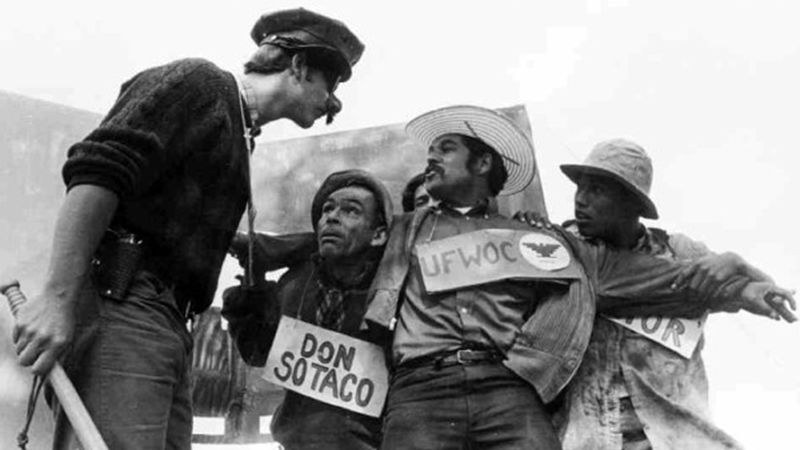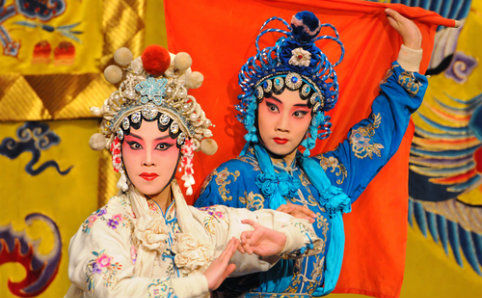

This dialog contains the full navigation menu for this site.

“Theatre classes”—traditionally seen as not serious, lightweight, most definitely non-academic. But anyone who subscribes to those stereotypes should take a peek into Associate Professor of Theatre Arts Robin Reese’s Theatre 208: Theatre in Diverse Cultures class. You’re as likely to hear “Aristotle” as “Ibsen” in class, as likely to discuss portrayals of race as the naturalism of Chekhov’s Uncle Vanya.
Using theatre for perspective, Reese wants to expose her students to cultures they may not know. “In most of our acting and theatre classes we’re working with the Stanislavsky/European method of theatre,” she explains. “Sometimes they’ll get Asian forms, but in this class we’re looking at Afrocentric, Latin-centric, Japanese, Chinese, GLBTQA theatre. The goal is for students to understand as watchers and participants that theatre is very rich, very diverse, very interesting.”
Learning about theatre in other cultures can influence a student’s perspective but Reese’s goal is more ambitious—to influence not only their awareness of other cultures but how they may incorporate that awareness into their own performances. She points out that, when students are performing, “even if a play is written in European style students can bring in other cultures. This gives the student training in a whole ideology.”
The Latin-centric section of the curriculum focuses on commedia, a form of theatre that started in the nineteenth century and is “a big part of Latin America theatre,” Reese explains. “It’s unscripted, like a clown or damsel in distress or slave, characters that actors would perfect over time.” Reese describes the form as “colorful, inclusive of the audience. There’s a musicality, a sense of clowning with the most pathetic, sorrow-filled moment.” Laughter, sadness, even strong political statements can be woven in. As a video example, Reese shows her class a performance of Los Vendidos by El Teatro Campesino (The Farmworkers Theatre—a theatrical group started during the 1965 grape strike by Cesar Chavez’s United Farmworkers Union).
For someone not familiar with the work of an actor (other than the finished product), observing the last segment of Reese’s class can be a learning experience. Students are given the opportunity to practice the acting methods they have just studied. It begins with Reese telling her students to “warm up your bodies!” before they turn to the day’s theme. For the Latin-centric class that means acting out the seven main emotions of commedia—happy, sad, confused, surprised, angry, worried, and love. Reese shouts instructions: “Happy! Let’s not be happy at a 3! Let’s be happy at an 8!” “10” brings screams and jumping around. For “Sad!” 2 is a sad face, 7 is crying, and at 11 they collapse in wailing. The movements, the sounds go on through the other emotions, and then Reese has the students mix it up a little: “Enter with one of those emotions at full height and then change it to something else, bring that one to full height and exit.” The students react with enthusiasm. “Clowning is an exaggeration,” Reese says, and her students prove it.
In another class segment, students are introduced to Chinese theatre. “What created the rise of theatre in Europe’s medieval period?,” Reese asks. “Cycle plays. Theatre began in the churches to get people to understand the Bible, the birth, life, and death of Jesus. Then we get to the mystery plays, Easter.” What does all this have to do with Chinese theatre? “The first Chinese theatres were religious, 300 years before the Europeans.” In addition to being prolific, the Chinese were also careful to preserve their work, Reese notes; there are only three extant Greek plays while Chinese extant plays number 400. “There is a richness [to Chinese theatre] that I think we can benefit from.”
Reese admits that she wasn’t aware of the history of Chinese theatre until doing her research for this class and she raises questions about its relation to European theatre. “Did we steal theatre from the Chinese? Chinese theatre was developing by 1200, with many, many people performing their roles.” She notes that European theatre didn’t include domestic tales until the seventeenth century, but they were being performed “long before that in China. The Chinese were doing it hundreds of years before Europe.”

Peking Opera
Like Latin-centric theatre, Chinese theatre utilizes bright colors and exaggerated movements and sounds. Reese shows the class a video from the Peking Opera, while she explains, “Narrative is important but the delivery of the narrative is also important. There’s movement the entire time—it’s exhausting.” For the last segment of the class, then, the students get to act out the theatrical styles they have seen. First they sing the children’s song, “Twinkle Twinkle Little Star” quietly, loudly, playing with their voices for effect. The room quiets as they work on communicating to another person with only facial expressions, no dialogue, mimicking some of what they had seen in the video.
Not everyone in this class is a theatre major. Dannette Yahn, a Penn State Altoona freshman, is majoring in astronomy education. She took Reese’s “Fundamentals of Theatre” class last semester and loved it so much she came back for this course. Yahn admits that theatre class “gives you a way to be expressive and get out of your comfort zone”—something she demonstrated quite clearly when her normally soft voice rose above the other students during the vocal exercise. This particular course also appeals to her for its cultural facet—“it’s a good opportunity to explore the world. I like Asian cultures.”
Aaron James’s outlook is more traditional—he’s a diehard theatre major. “I was an education major and I changed because I couldn’t see myself doing anything else.” He has been involved in theatre since high school, even working “two years with one of [Reese’s] students before I met her.” Professor Reese is now a major influence on his life because, he says, “she makes sure her students get where they want to be.” And where he wants to be is studying theatre in graduate school: “It’s just like any other profession. You just have to go for it. You understand how hard it’s going to be and you still do it.”
As the class closes, students mill about, gesturing, laughing, moving, even as they put the mats away. Reese observes, “You don’t often have students continue the class once it’s over.” But the energy in the room is still high, the students comparing notes on their actions and reactions. As it should be with college courses, lessons from this class will stay with these students whether this is their major or not.


